If you’re on the lookout for plants with beautiful foliage, then look no further than the watermelon peperomia. With its large green leaves and bushy appearance, this plant will surely make your home or garden look more alive.
Interestingly, it’s also one of the easiest plants to propagate, so making more of them won’t be a problem.
And with that in mind, how do you propagate a watermelon peperomia? There are three known ways to propagate this plant:
- Propagating watermelon peperomia from its leaf cuttings.
- Propagating from its stem cuttings in water.
- Propagating from its stem cuttings in soil.
In this article, you will learn how to propagate watermelon peperomia through these methods. You will be provided with step-by-step instructions, so you don’t have to worry about making a wrong move. You’ll also learn more about watermelon peperomia, the best time to propagate it, and so much more.
What Is Watermelon Peperomia?
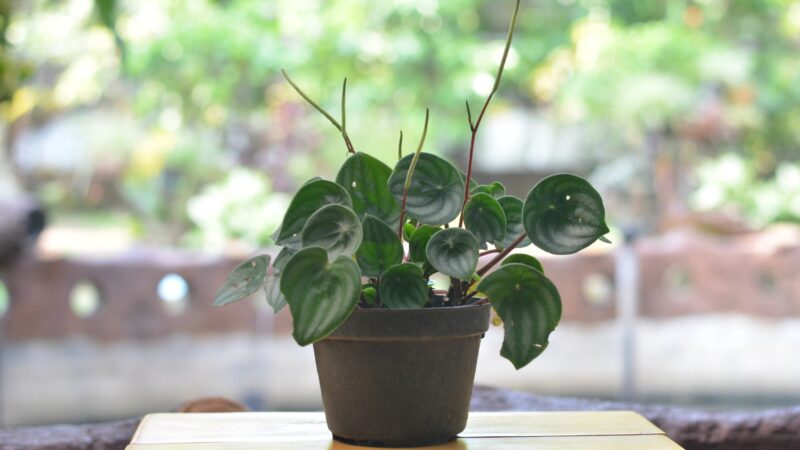
The peperomia argyreia, or the watermelon peperomia as it is more popularly known, is a plant belonging to the peperomia family. It is characterized by its large fleshy leaves with markings that share a resemblance to that of the outer watermelon rind. It is a medium-sized plant that can grow up to 12 inches tall and can grow lovely thick foliage.
This tropical plant is a native of South Africa, making it comfortable around warm and humid areas. It also hydrates like succulents, so it doesn’t need you to remember a frequent watering schedule. While it is a flowering shrub, the watermelon peperomia’s most iconic feature is its leaves.
- Scientific Name and Common Names: Peperomia argyreia
- Appearance: The watermelon peperomia is a shrub that has large fleshy leaves that are generally light green but with dark green patterns from the base to the tip. It also has a notable red-colored stem, although it is usually hidden underneath the thick foliage. At times, the stems also appear yellow or white. During the summer it grows flowers that appear like white or yellow spikes protruding from the foliage.
- Origin: Bolivia, Brazil, Ecuador, and Venezuela
- Indoor or Outdoor plant: The watermelon peperomia may either be outdoor or indoor plants. As long as it receives its ideal amount of sunlight and water, it can survive wherever it may be planted.
When to Propagate a Watermelon Peperomia?
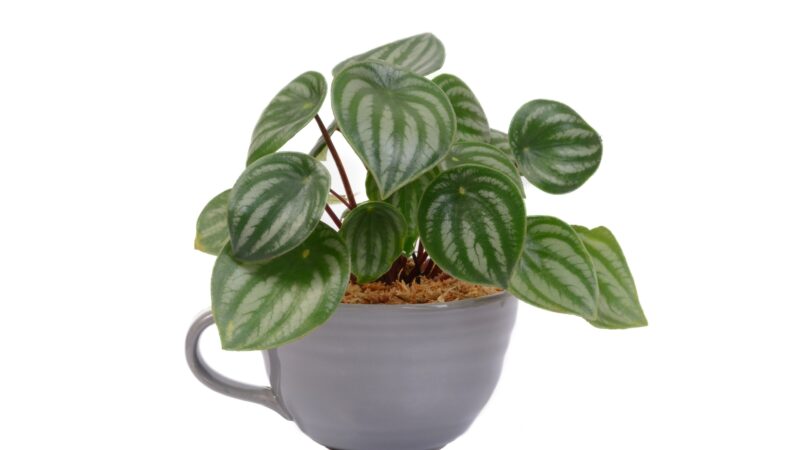
The best time to propagate watermelon peperomia is during the late spring and summer seasons. As earlier discussed, the watermelon peperomia is a tropical plant. As such, it is most active when the temperature is warm, so it’s bound to bloom and grow into a healthy plant.
However, take note that watermelon peperomia plants take around two to four weeks to grow their roots during propagation. This means that it is best to plant them as soon as the temperature reaches between 50 to 80°F in the late spring. This will give it enough time to grow and thrive during the hot summer.
Why Should You Propagate a Watermelon Peperomia?
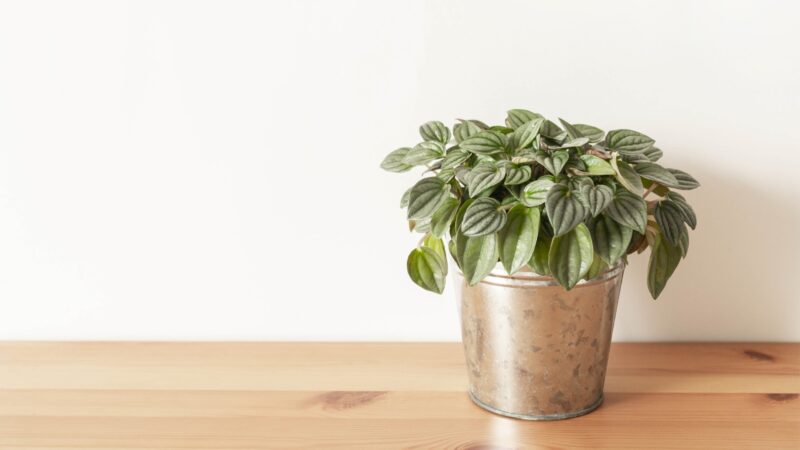
Propagation is the process by which plants multiply using their healthy parts. Here are some of the reasons why you should propagate watermelon peperomia:
- By propagation, you can produce more watermelon peperomia at a faster rate. Leaf and stem cuttings are often used in propagating this plant, and the roots will start to grow within weeks – and eventually grow into a new plant. In contrast, growing directly from seeds will take much longer.
- By propagating, you trim healthy parts of the watermelon peperomia to produce more of it. In a way, it helps with pruning the plant to make it look more balanced without throwing away the removed parts.
How to Propagate a Watermelon Peperomia?
How to Propagate a Watermelon Peperomia Using Leaf Cuttings?
Step 1: Before anything else, observe the plant so you can select which leaves to use. The best leaves to use are the ones with no damage or discoloration.
Step 2: Then, cut the leaf from the stem with part of its petiole still intact. For this step, you can use a pair of garden shears like the Fiskars 356922 Multi-Purpose Garden Shears to cut the leaf. But before you do so, make sure the scissors are clean and sterilized to keep infections away.
- 7-IN-1 GARDENING TOOL: Versatile pruning shears for gardening...
- MAXIMUM POWER AND PRECISION: For these garden scissors, trimming...
- LONG-LASTING AND RELIABLE: Trim Scissors with stainless steel...
- QUALITY GARDEN TOOLS: Designed to help you cultivate a better...
- INCLUDES: 1 pair Fiskars Multi-Purpose Hand Pruner with Sheath...
Step 3: Once you have your leaf cuttings, the next step is to plant them in the soil. Plant the leaf upright, with the part with the petiole on the ground.
Step 4: After planting the leaf cuttings, simply mist the water all over it. Stop when the soil already looks moist, and make sure not to soak it.
Step 5: For best results, place the plant in an area where it can receive bright light. However, watermelon peperomia can dry up under direct sunlight, so indirect sunlight exposure works best.
Step 6: The leaf cuttings will start to sprout in about a month. During this period, continue spraying it with water when the upper layer of soil is already dry.
Usually, it would take around five months for the leaf cuttings to grow large and multiple stems with large leaves. At this stage, your watermelon peperomia is already mature enough to be moved to a bigger pot. Then, simply make sure it gets enough water and sunlight – and watch it thrive.
How to Propagate a Watermelon Peperomia Using Stem Cuttings in Water?
Propagating watermelon peperomia in water is also a popular method. However, it takes some time before it can grow roots, so this is a good option if you’re not in a hurry.
Step 1: Choose a healthy stem with a big healthy leaf to ensure successful propagation. You will know that it’s healthy if it doesn’t have any holes, discoloration, or damage.
Step 2: With a sterilized garden shear, cut off the stem with the leaf still intact. Make sure to do so carefully so as not to cause damage to the stem.
Step 3: Place the stem in a glass vase that’s filled to about ⅔ with water. It is advised to use a clear vase like these 6-inch Tall Clear Glass Vases, so you can observe how your plant is doing.
- PACKAGE INCLUD: 12 transparent cylindrical glass vases with a...
- HIGH QUALITY: Transparent glass vase is made of solid glass,...
- WIDELY USED: The high glass vase is suitable for flowers, dried...
- DECORATION: The perfect choice for household flower arrangement....
- SAFE PACKAGING: Each set of 12 cylindrical transparent vases is...
Step 4: Make sure to change the water every week to keep it from harboring bacteria and other harmful microorganisms. However, if the water seems murky or dirty, replace it immediately, even if it has not yet been a week.
In about two months, the stem cuttings will start to grow roots. In a few more months, it will grow big enough to allow it to be transplanted into a new pot.
How to Propagate a Watermelon Peperomia Using Stem Cuttings in Soil?
Aside from planting your stem cuttings in water, a faster way to propagate them is by planting them in soil.
Step 1: The first step is to detach the stem from the mother plant with a garden shear. For best results, make sure that the big healthy leaf is still intact.
Step 2: The next step is to plant the stem upright into the soil. As much as possible, use well-draining soil. A good option to consider is the Miracle-Gro Houseplant Potting Mix, which also contains fertilizer to help the plant stem cuttings grow.
- Growing indoors is easy under the right conditions; Miracle-Gro...
- Recommended for growing beautiful indoor houseplant varieties...
- This indoor plant soil is less prone to gnats, thanks to the...
- Certified by the Mulch & Soil Council as a quality product in...
- A single 4-qt bag fills an 8-inch container; for even more...
Step 3: After planting the stem cuttings, sprinkle them with water until the soil is moist. Then, move the plant to an area where it can receive bright yet indirect sunlight.
During the waiting period, continue to give it water when the topsoil is already dry. The stem cuttings will take around two to six weeks for the roots to grow. Once the new watermelon peperomia is big enough, you can then move it to a bigger pot.
How to Propagate a Watermelon Peperomia From Leaves (Without Stem)?
Step 1: Choose healthy leaves from your watermelon peperomia plant. Make sure that it does not have any damage or discoloration to ensure successful propagation.
Step 2: With a pair of garden scissors, cut the leaf across the part of the leaf that’s above the petiole. In doing so, make sure the scissors are sterilized to keep them from being infected.
Step 3: Then, plant the leaf cuttings about an inch underneath the soil. Make sure that the end where you made the cut is the one that’s under the soil.
Step 4: Once potted, mist the leaf cuttings until the soil is moist. Avoid overwatering it to prevent it from rotting.
Step 5: To grow well, make sure to place it in an area where it receives bright light, but not directly from the sun.
In about a month, you will start to notice small sprouts coming from the leaf. Continue to water the plant and put it under a bright light to help it grow further.
In a few more months, the stems will grow longer and thicker. That’s the right time to carefully transfer the new plant into a bigger pot.
Watermelon Peperomia Care After Propagation
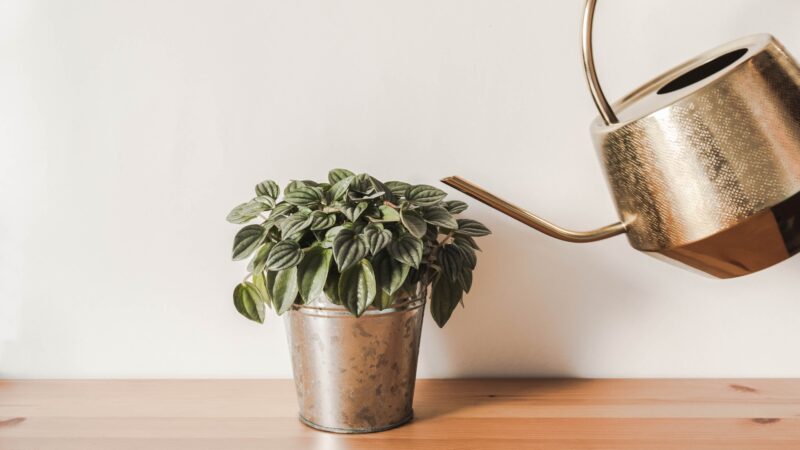
After propagation, caring for your watermelon peperomia will be a breeze. However, it is vital to keep the following pointers in mind to keep your plant healthy.
- Place the plant in an area where it can receive medium but indirect light. If the light is too bright, it might burn the cuttings.
- Make sure the temperature is between 50 to 80°F. As a tropical plant, watermelon peperomia loves warm environments. If the temperature drops below this range for extended periods, the plant may experience stunted growth. It may even suffer from frost damage if the temperature reaches freezing levels.
- Maintain the humidity levels at 50%. Watermelon peperomia loves humidity. It thrives when the air has high moisture levels, so this will help it grow into a healthy plant.
Common Problems When Propagating a Watermelon Peperomia Plant
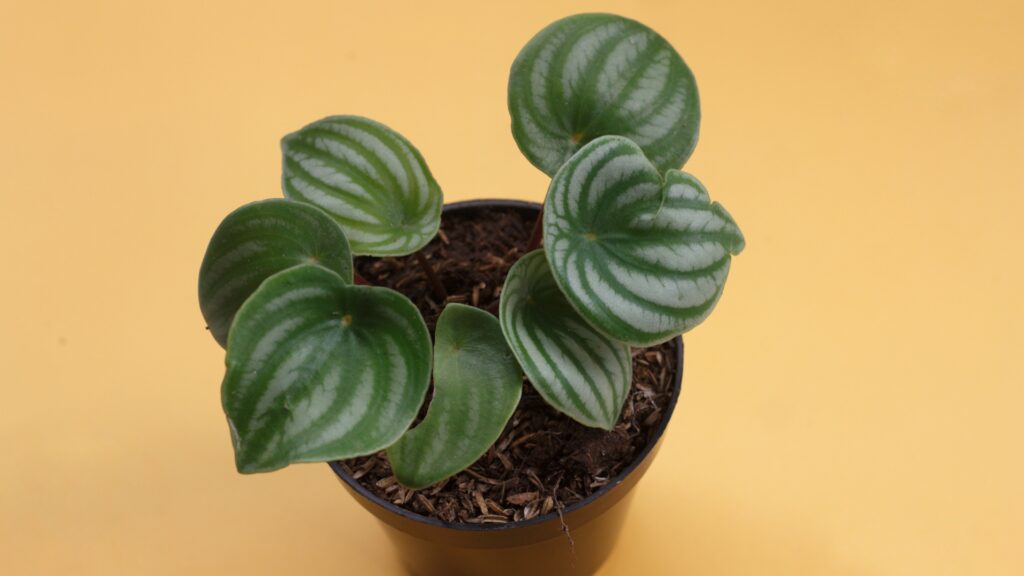
- Fungal infection. During the waiting period of propagation, the cutting does not yet develop its immune system against fungal infections. If it is left in an environment that’s generally moist, it can easily attract fungi and bacteria and leave it infected.
- Pest infestation. Another common problem is pests. Since cuttings are made of leaves or stems, these are the parts that pests like aphids and mealybugs love munching on. Since these cuttings are already separated from the mother plant, these pests can easily devour them.
- Root rot. If the cuttings were given too much water, the soaked roots may start to rot. As a result, the watermelon peperomia may not propagate successfully.
- Drying. Plants need water to survive. They especially need water if they are growing their roots. If you forgot to water your watermelon peperomia cuttings during propagation, they may end up dehydrated. If it is left in that state for a long time, the plant may fail to propagate.
Frequently Asked Questions
What to Do With a Peperomia Watermelon Mother Leaf After Propagation?
Once the watermelon peperomia mother leaf has grown new roots, the best solution is to move it to a new pot. As much as possible, make sure that its surroundings are supportive of its growth.
This includes a temperature of around 50 to 80°F, medium to bright light, high humidity, and giving it water at least once a week or every two weeks.
Why Does My Peperomia Watermelon Cutting Keep Rotting in Water?
In the case of propagating the watermelon peperomia in water, the plant may rot if the water was not replaced after a long time. Thus, the best way to prevent the roots from rotting is to replace the water at least once a week.
Bear in mind that watermelon peperomia requires hydration similar to succulents. If it is soaked in water for prolonged periods, the roots will similarly start to rot.
So once your cutting has grown into an independent plant and planted on the soil, it is advisable to only mist it when the top layer of soil is dry.
How Long Does It Take To Propagate Watermelon Peperomia?
The average duration to propagate watermelon peperomia on soil is around six to eight weeks. In the first two weeks, the cuttings will start to grow their roots. The succeeding period will be the time for the roots to establish themselves and allow the plant to grow independently.
In the case of propagation of water in water, the average duration will be around one to two months. This also depends on how healthy the cuttings are for propagation. For best results, it’s best to choose the stem or leaf that does not have any damage or discoloration.
List of Sources
Watermelon Peperomia (Peperomia Argyreia) – https://libguides.nybg.org/watermelonpeperomia
Peperomia Argyreia – https://plants.ces.ncsu.edu/plants/peperomia-argyreia/


